Arguably, the greatest dream match that could have happened, The Undertaker vs. Sting, will remain a fantasy. Recently, it resurfaced on online wrestling Discord due to Sting’s retirement match at AEW Revolution. And fans being fans, comparisons between these legends are being made again.
Unfulfilled Fantasy
Getting the cliches out of the way, Sting and The Undertaker are more than men. They are icons. Their names are synonymous with eras, movements, and companies. Both are standard bearers, childhood heroes, and, for the most devoted fans, Gods.
Their similarities go beyond their dark aesthetics. Both had a history of reinvention. Both performed across changing periods in wrestling at a consistently high level. Each has overcome, at points, terrible creative that arguably never diminished their auras.
For decades, each maintained relevance through reinvention while staying within the core of their gimmicks. To different fans, they represent different ideas of what wrestling is and should be. Some, naturally, because it’s wrestling (and we have the action figures), want our heroes to fight in some capacity!
It’s all we can do. The brief window through which they could have fought each other in WWE passed. It’s the dream match that got away. Fans were left to fantasize.
Fantasy to Comparison
Since the creation of AEW, the division of wrestling fans has created a culture of wrestling tribalism, which, for some fans, has given way to comparison to discuss which legend is better, yet some fans have turned this comparison into another battle of the culture war. It makes the comparison more than about the wrestlers themselves—more about AEW vs. WWE and about “my company’s is better than yours.”
The problem with this is that it’s not an easy comparison. It’s complex because the nature of tribalism and one-upmanship means key elements of context get missed. Also, as time goes on, there is a conflict between memories of the past and feelings now that have changed.
This is a complex analysis that requires two articles to deal with two aspects of the comparison. So, in this article, I’m going to analyze the fantasy. The booking, creative decision, and presentation of both men’s characters and final stories. In my follow-up, I’m going to delve into the more complicated area of fan tribalism.
Gods and Mortals
Few wrestlers get put on a pedestal of Sting and The Undertaker by the fans and their co-workers and bosses. Part of this is respect for their contributions to the business. Their visible passion for performing and entertaining the fans. Part of it is childhood nostalgia, growing up and seeing their characters grow along with the fans themselves.
Another part is their commitment to their gimmicks. The Undertaker especially lived the gimmick as an undead, supernatural being well past the death of kayfabe. ‘Taker passed on opportunities in other media beyond wrestling. This showed a commitment and respect for wrestling and for the fans not since replicated. All to keep the illusion of his persona (ironically for a dead man) alive.
This idea of the “illusion” is perhaps the most important and comparable aspect of their final runs and retirements.
At its best, pro wrestling can be magic. The make-believe that makes a worked sport feel real is complex. The wrestler’s commitment, ability form it, and the stories told in the ring. How the creative exaggerates their strengths as superhuman. How the booking hides the strings with smoke and mirrors to make us forget for that we are seeing two grown men in underwear playfight.
It’s what makes mortals into Gods. In the case of Sting, this magic was preserved in AEW. It’s the magic that repeatedly was lacking in The Undertaker’s final WWE run. Nonetheless, time has also shaped their legacies. Time has yet to drain away the euphoria of Sting’s final match.
Recency Bias
AEW Revolution 2024 is fresh as the glass cuts on Darby Allin’s back. Controversy around glass spots and opponents, AEW sold out the Greensborough Coliseum. This was due in large part to the marketing of Sting’s final match.
AEW presented Sting throughout his run as a special attraction and as a legend with respect and admiration. Through clever booking, they somehow made Sting, the man and character, sixty-four years old, look both vulnerable and yet formidable.
One moment, Sting was a powerbomb away from the end. The next, Sting was leaping offsets and, to the shock of even Darby. A large part of this is Sting’s ability. However, the smoke, mirrors, and choice of opponents allowed that old magic to remain real and yet modern. This was AEW’s booking.
As I wrote about in my matchpoint for Sting’s final match, this had the potential to be the perfect retirement match. Various wrestlers, including The Undertaker, have chased this type of perfection and failed. The fact that a week has barely passed, and the adrenaline is still pumping, does affect fans’ judgment.
Especially because a few years ago, at the start of the Pandemic, there was a similar sentiment about The Undertaker’s retirement. The issue is that as time passes, the standards of wrestling change significantly.
But more crucially, some things cannot be compared. Sting came back from a serious career-ending neck injury. However, throughout his last few years, The Undertaker underwent surgery after surgery not only for his health but also to get back in the ring for one final perfect match. That wear and tear was noticeable.
Streaks are Not Comparable
Some fans have tried to compare and say Sting had a better ‘streak’ than The Undertaker’s legendary WrestleMania run. This is a perfect example of an inherently flawed comparison. Comparing a streak of decades to a few short years is overly simplistic, especially because it misses several wider contextual points.
The most obvious is huge when some have tried to compare match quality: intention. The Undertaker’s WrestleMania streak was accidental. The match quality, until it became a storyline in the build-up to Wrestlemania 21 against Randy Orton, was neither an active thought nor a promise. From this point, the streak became a defining feature of The Deadman’s career.
WWE’s marketing and creative lionized the streak’s importance over time, but it was unintended. Sting’s last run was clearly planned.
Mythos in Decline
The strength of the mythos WWE and fans built around the streak meant that when it ended at WrestleMania XXX, speculation began. When would the final bell toll? Given how the Undertaker was rushed to hospital with a severe concussion, it seemed sooner rather than later. But then, because history unfolded the way it did, it’s easy to fit a nice, neat narrative to a complex road to retirement.
Highs and lows meant that by the time The Undertaker reached his retirement match, the character’s aura had been chequered by the inability to book and injuries that impacted the quality of matches. Both the man and gimmick seemed in limbo. Moments of hope were intermixed with disappointing creativity. Unlike Sting, the supernatural aura once possessed by the Dead Man in the ring was in decline.
Black Spots on the End of a Legacy
WrestleMania bouts continued to not live up to The Undertaker’s reputation. The match against Bray Wyatt ended in disappointment. The match was underdelivered, and the man some fans deemed to be the new Undertaker was beaten again. Shane McMahon was an odd choice. A planned retirement for Roman Reigns failed to elevate the Big Dog as the man. It failed in its execution and intent.
There were highlights: an intense and brutal series of matches with Brock Lesnar in 2015 and an excellent tag team match with Reigns as the Graveyard Dogs, but this couldn’t cleanse the palate long-term of the bad taste left by two low points in Saudi Arabia.
An overdue dream match with Goldberg exposed both men’s age and weaknesses. The re-run of The Brothers of Destruction vs. D-Generation X killed all illusions that these icons still had it.
Although Undertaker retired with an excellent cinematic match at WrestleMania 36, the previous failings have remained at the forefront of some fans’ minds. Human beings tend to spot the black dot on a white canvas and fixate on it. We remember the bad often before the good.
Of Its Time
The Boneyard Match has suffered historically for four reasons: things that could not be foreseen in April 2020. Like Sting’s retirement match, things may change, and they will inevitably change how it is remembered as much as how we felt.
First, culturally, since the pandemic, many individuals have wanted to move past that time. Forget the terrible experiences that many people, wrestling fans or not, experienced.
At best, we were restricted. At worse experienced trauma. People died. Highpoints in both WWE and AEW have become moments of that time. AEW’s first Stadium Stampede was epic, but rewatching is a reminder of that ‘new normal.’ The zeitgeist moved on.
Second, rewatching the match feels almost ironically AEW-like in terms of the use of humor and meme-worthiness. I’m shocked at AJ Styles’ response to ‘Taker’s ‘Go out like a man!’ ‘No!’ didn’t become a bigger thing. It was perfect for the time and ‘Taker’s limitations. However, these intended/unintended moments of levity ill-fittingly connect with ‘Taker’s wider legacy and characterization.
Third, The Firefly Funhouse Match, especially since Bray’s untimely death, is better recalled as the greater cinematic achievement. The match’s cleverness is that it’s a meta-narrative showcase of creative potential that was never fully utilized.
Finally, the build to the match itself needed to be clarified. AJ Styles challenged Mark Calaway, the man behind the gimmick, in an excellent series of shoot promos. The problem was that the concept of Calaway’s “The Unholy Trinity” was not fully fleshed out or explained in the build. It was an incomplete story during a period of unsatisfactory WWE creative.
Remembers of The Last Ride
To prepare for this piece, I rewatched clips of the Last Ride documentary. Despite watching it at the time, I had forgotten how much this series made me respect Mark Calaway, the man behind the gimmick’s dedication and love for wrestling.
What I remembered was, ironically, the humanization of a man who pretended to be years old to be dead. Unintentionally, for me, this break of kayfabe, seeing the man struggle through surgeries to try and have one more great match, generated the wrong kind of sympathy wrestlers want.
I sympathized with the man who had fallen into the cliché of the fighter who did not know when to throw in the towel. Yet what stood out also were the booking failures.
The show displays Undertaker’s close bond, almost brotherly, with Vince McMahon . Yet, I question why Vince did not do more creatively or as a businessman to protect The Undertaker character and Mark Calaway’s declining body with smoke and mirrors. Both the gimmick and the man deserved that.
Conclusion
Both Undertaker and Sting left with a victory. Both men got to ride off into the sunset, or sunrise in the case of The Undetaker, on their motorcycles. Both men’s final matches dealt with the theme of a man facing his mortality.
Although in their ends, smoke and mirrors were used to preserve the heroes of old, the lack of foresight and protection afforded to The Undertaker’s broken-down body exposed him as a man long before the end.
In AEW, fans got the eternal Sting. The hero of old, a superhuman being. Sting was ageless. Mark Calaway was aged, and his story, ending as the “Unholy Trinity”- himself, The American Badass, and The Undertaker did the best it could. Like a lot of WWE during the 2010s, there was no foresight, even for one of the company’s most important figures.
As time has moved on, some fans of both sides of the cultural war need to remember the strain these men and women have taken over the years. Both men deserve respect, but Mark Calaway,
The Undertaker deserves acknowledgment for continuing through significant pain and limitations. In hindsight, the failures need to be re-examined as failings in booking and management more than his own. Although he wanted one more perfect match, he would not be the first or last to pursue perfection.
More From LWOS Pro Wrestling
Header photo – WWE – Stay tuned to the Last Word on Pro Wrestling for more on this and other stories from around the world of wrestling, as they develop. You can always count on LWOPW to be on top of the major news in the wrestling world, as well as to provide you with analysis, previews, videos, interviews, and editorials on the wrestling world.






